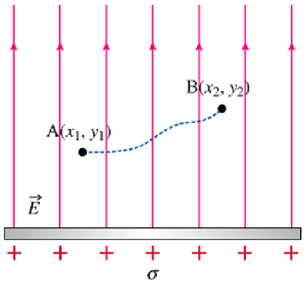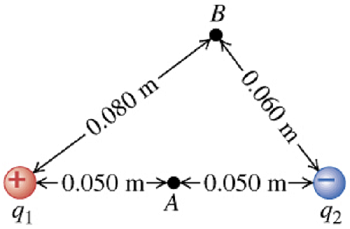Reference no: EM132459864
Assignment - Electric Potential Questions
Section 1 - Potential Difference and Potential near a Charged Sheet
Q1. Let A = (x1, y1) and B = (x2, y2) be two points near and on the same side of a charged sheet with surface charge density +σ. The electric field E→ due to such a charged sheet has magnitude E = σ/2∈0 everywhere, and the field points away from the sheet, as shown in the diagram.

Part A - What is the potential difference VAB = VA - VB between points A and B?
Q2. At a certain distance from a point charge, the potential and electric field magnitude due to that charge are 4.98 V and 12.0 V/m, respectively. (Take the potential to be zero at infinity.)
Part A - What is the distance to the point charge?
Part B - What is the magnitude of the charge?
Part C - Is the electric field directed toward or away from the point charge?
Q3. Two point charges q1 = 2.30 nC and q2 = -6.80 nC are 0.100 m apart. Point A is midway between them; point B is 0.080 m from q1 and 0.060 m from q2 (the figure). Take the electric potential to be zero at infinity.

Part A - Find the potential at point A.
Part B - Find the potential at point B.
Part C - Find the work done by the electric field on a charge of 2.50 nC that travels from point B to point A.
Q4. Two large parallel conducting plates carrying opposite charges of equal magnitude are separated by 2.20 cm.
Part A - If the surface charge density for each plate has magnitude 47.0 nC/m2, what is the magnitude of E→ in the region between the plates?
Part B - What is the potential difference between the two plates?
Part C - If the separation between the plates is doubled while the surface charge density is kept constant at the value in part (a), what happens to the magnitude of the electric field?
- doubles
- stays the same
- halves
Part D - If the separation between the plates is doubled while the surface charge density is kept constant at the value in part (a), what happens to the potential difference?
- doubles
- stays the same
- halves
Q5. A total electric charge of 3.50 nC is distributed uniformly over the surface of a metal sphere with a radius of 18.0 cm. The potential is zero at a point at infinity.
Part A - Find the value of the potential at 55.0 cm from the center of the sphere.
Part B - Find the value of the potential at 18.0 cm from the center of the sphere.
Part C - Find the value of the potential at 17.0 cm from the center of the sphere.
Section 2 - Electric Potential, Potential Energy, and Force
Learning Goal: To review relationships among electric potential, electric potential energy, and force on a test charge.
Q1. This question is a review of the relationship between an electric field E→, its associated electric potential V, the electric potential energy U, and the direction of force on a test charge.
Part A - Electric field lines always begin at _______ charges (or at infinity) and end at _______ charges (or at infinity). One could also say that the lines we use to represent an electric field indicate the direction in which a _______ test charge would initially move when released from rest. Which of the following fills in the three missing words correctly?
(positive; negative; negative)
(positive; negative; positive)
(negative; positive; negative)
(negative; positive; positive)